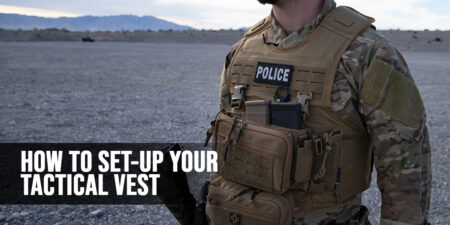In the line of duty, law enforcement officers and military personnel often face life-threatening situations. Even ordinary civilians can find themselves in scenarios where protective gear proves crucial. Bulletproof vests have emerged as a vital piece of equipment in such instances. It has evolved over time to offer increasing levels of protection against bullets and other threats, saving countless lives.
But who invented bulletproof vests? How has it transformed from its initial versions to the high-tech protective gear we have today? In this blog post, we will dive deep into the fascinating history of the ballistic vest and explore its evolution up to the present-day version.
At Safe Life Defense, we have dedicated ourselves to creating high-quality body armor that is designed to keep everyone safe, from ordinary civilians to SWAT teams. We have a wealth of expertise and knowledge in this field, which we look forward to sharing with you in this post.
As we explore the history of bulletproof vests, you will learn about the various materials and technologies used over the years. We will also discuss the challenges faced by inventors and innovators in designing protective gear that is both effective and wearable. This journey through time will provide valuable insights into how the bulletproof vests has become an indispensable part of protective gear to serve people in life-threatening, dangerous situations.
Early History: The Man Who Invented Bulletproof Vests
The concept of body armor dates back thousands of years. Throughout history, warriors have worn armor made from materials such as leather, chainmail, and metal plates. In more recent times, protective vests have been designed to shield individuals from bullets and other projectiles. The journey of the modern bulletproof vest began with an unlikely inventor and an equally unlikely material.
The Inventor of Bulletproof Vests
In the late 19th century, a Polish inventor named Casimir Zeglen, who was also a Roman Catholic Priest, developed a protective vest made from layers of silk fabric and steel plates. Zeglen was inspired to create this vest after the assassination of the mayor of Chicago, Carter Harrison Sr. He was determined to find a way to protect individuals from firearm threats. His vest was made up of a silk handkerchief with metal plates, which acted as a protective outer layer, and an inner layer of silk fabric to absorb the bullet’s impact.
To demonstrate the effectiveness of his invention, Zeglen organized a public test in 1897, during which he shot himself while wearing the vest. The vest successfully stopped the bullets, and Zeglen walked away unscathed. This public demonstration attracted the attention of the Chicago Chief of Police and the Brooklyn Eagle newspaper, and Zeglen’s vest quickly gained widespread recognition.
World War II's Role in the History of Body Armor
Zeglen’s invention marked a significant milestone in the history of the bulletproof vest. However, it was not until World War II that body armor became more widely used. During the war, steel body armor was employed to provide protection against small arms fire. Steel plates, commonly referred to by soldiers as “flak jackets,” were worn to shield them from shrapnel and fragments from explosive devices. These early vests were heavy and cumbersome, limiting the wearer’s mobility and comfort.
As advancements in materials science and technology continued, the search for more effective and wearable body armor led to the development of the new flak jacket in the 1950s for the Vietnam War. These jackets were made from ballistic nylon, a type of high-strength fabric, and provided protection against shrapnel and low-velocity bullets. While not entirely bulletproof, flak jackets were a significant improvement over previous armor designs. They were lighter, more flexible, and allowed for greater mobility on the battlefield.
The history of the bulletproof vest has been marked by a continuous quest for better materials and designs. These innovations were sought after to provide effective protection against the ever-evolving threats faced by military personnel, law enforcement officers, and civilians. This search would eventually lead to the revolutionary innovations of the modern era.
The Modern Evolution of Bulletproof Vests
The mid-20th century brought about a significant breakthrough in the development of bulletproof vests. The invention of a new synthetic fiber with remarkable properties opened up new possibilities for protective gear. Stephanie Kwolek, an American chemist working at DuPont, stumbled upon a polymer solution that could be spun into a fiber with high tensile strength and stiffness. In 1965, this fiber was introduced as Kevlar.
Kevlar's Role in the Modern Evolution of Bulletproof Vests
Kevlar, with its lightweight and flexible properties, quickly became a revolutionary material for body armor after its adoption by Stephanie Kwolek in 1966. Bulletproof vests made of Kevlar offered protection against bullets without the bulk and weight of steel plates. The fibers in the Kevlar fabric were tightly woven to create a barrier that could dissipate the energy of a bullet upon impact, reducing the risk of injury.
In the 1970s, a former U.S. Marine and pizza delivery shop owner named Richard Davis founded Second Chance, a company that would change the face of body armor. Davis designed the first all-Kevlar vest, combining layers of Kevlar fabric with a shock-absorbing backing. To prove its effectiveness, in what could be interpreted as an ode to Zeglen, he famously shot himself while wearing the vest on multiple occasions. His demonstrations attracted the attention of law enforcement agencies across the United States.
Soon, Kevlar vests became an essential part of the uniform for police officers, providing them with lightweight protection against handgun rounds. Bulletproof vests not only saved lives but also allowed law enforcement officers to confidently perform their duties in dangerous situations.
The widespread adoption of Kevlar vests marked a significant shift in the approach to body armor. As vest designs continued to evolve, improvements were made to enhance ballistic protection, comfort, and wearability. Bulletproof vests became more ergonomic, allowing for greater mobility and a better fit.
The Continuous Quest for Ultimate Protection
However, the quest for better protective gear didn’t stop with Kevlar. Researchers and innovators continue to explore new materials and technologies that could further improve the effectiveness of body armor. As threats become more varied and sophisticated, the need for advanced protective gear has only increased.
The modern evolution of the bulletproof vest marked a turning point in the history of body armor. From the early designs of Casimir Zeglen to the innovative Kevlar vests of Richard Davis, the journey of the bulletproof vest has been marked by a relentless pursuit of better protection for civilians, military personnel, and law enforcement agencies alike.
The Present Day and Future Innovations
The search for better protective gear continues today, with technological advancements and new materials driving the development of increasingly effective bulletproof vests. In recent years, researchers have explored the use of innovative spider silk, known for its strength and elasticity, as a potential material for body armor. Although sourcing natural spider silk in large quantities is a challenge, scientists have made progress in producing artificial spider silk with similar properties.
Ballistic protection has come a long way from the silk handkerchief and steel plates of Casimir Zeglen’s invention. Modern bulletproof vests incorporate advanced materials such as ceramic plates and ultra-high-molecular-weight polyethylene (UHMWPE) to provide increased protection against high-velocity rounds and rifle bullets.
At Safe Life Defense, we are committed to staying at the forefront of these innovations. Our body armor is designed to offer the highest levels of protection while ensuring comfort and mobility. We understand that all Americans need to feel confident and secure in their protective gear, especially in dangerous situations.
Our bulletproof vests are made with multiple layers of advanced ballistic fabric, providing protection against various threats, including bullets, stabbing, and blunt force trauma. We offer a range of options to suit different needs and preferences, from concealable backpack panels for discreet protection to tactical vests for enhanced coverage.
Our focus on innovation and continuous improvement ensures that we deliver the best possible protective gear to our customers. We believe that everyone deserves access to high-quality body armor that can help keep them safe and secure in challenging situations.
Safe Life Defense and the Future of Bulletproof Vests
In summary, the history of the bulletproof vest is a testament to human ingenuity and the relentless pursuit of better protection against threats. The journey of the bulletproof vest reflects the progress of materials science, technology, and innovative thinking that has shaped our industry.
The future of body armor will be with Safe Life Defense, an industry leader committed to revolutionizing personal protection. Spearheaded by the visionary CEO Nick Groat, Safe Life Defense has demonstrated dedication to manufacturing body armor that seamlessly merges utility and useability with advanced material technologies. Notably, Groat’s introduction of the groundbreaking Flexible Rifle Armor to civilian and governmental sectors marked the beginning of the evolution of protective equipment like body armor. This innovation, designed to defend against high-velocity threats while maintaining comfort and mobility, highlights Safe Life Defense’s commitment to pushing boundaries. Further solidifying Safe Life Defense’s position at the forefront of innovation, Safe Life Defense unveiled the Hyper Concealable Hyperline Vest – the world’s thinnest IIIA vest. Through innovative engineering, Safe Life Defense has redefined expectations of body armor, setting new standards for effectiveness, discretion, and wearability. Undoubtedly, with their industry-leading technological advancements, Safe Life Defense emerges as the indisputable vanguard shaping the future of Body Armor.






